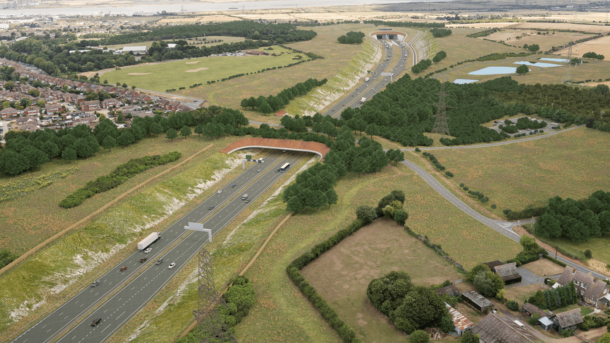The Lower Thames Crossing is the most ambitious road scheme since the M25, linking Kent, Thurrock and Essex and will consist of:
• Approximately 14.5 miles (23km) of new roads connecting the tunnel to the existing road network
• Connection between the A2/M2, A13 and M25
• New structures and changes to existing ones (including bridges, buildings, tunnel entrances, viaducts and utilities such as electricity pylons) along the length of the new road
• Two 2.5-mile (4km) tunnels, one for southbound traffic, one for northbound traffic crossing beneath the river
• A free-flow charging system, where drivers do not need to stop but pay remotely, similar to that at the Dartford Crossing
If you are keen to win work on the Lower Thames Crossing, we have set up Learning Pathways at both introductory and intermediate level covering many key aspects of sustainability.
On successful completion of any National Highways pathway you will be awarded a National Highways badge that you will be able to use to demonstrate your understanding of our sustainability issues.
Please note that you will need to be a member of the School to complete any of our learning pathways, if you are not already a member please register here.
Find out about our range of Learning Pathways – including our new fundamental resource “National Highways Sustainability and Net Zero” here.

The Benefits of Lower Thames Crossing
Quicker, more reliable journeys – The Lower Thames Crossing will almost double road capacity across the Thames east of London. The new route will have a maximum speed limit of 70mph. It will provide quicker, more reliable journeys locally and regionally between Kent, Thurrock and Essex, as well as nationally. This will help meet the demands of future traffic growth east of London.
Connecting communities and business – The Lower Thames Crossing will create better access on both sides of the river. This will improve journey times and reliability for communities and businesses, whether travelling short distances across the Thames to visit family or looking for better access to job or business opportunities.
Economy – The Lower Thames Crossing will provide access for local and regional communities to jobs, leisure and retail, benefiting development and economic growth on both sides of the Thames. The crossing will also improve journey times for national commercial traffic north and south of the river enabling quicker and more reliable access to key markets, resources and employees.
Environment – The Lower Thames Crossing will help reduce congestion in the Dartford area. This will decrease forecasted high levels of pollution, benefiting local communities.
Join us today!
By working with the Supply Chain Sustainability School, we are aiming to help up-skill your business, putting you in the best position to tender for work on the project and developing skills that will assist in working on other infrastructure projects. This will help your business grow and leave a legacy of a more capable, dynamic and sustainable supply chain.

 Learning Pathway Guidance
Learning Pathway Guidance